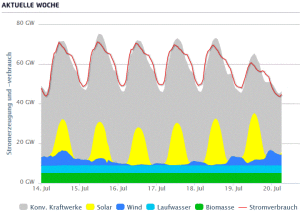“People need to remember that power production is a full time job, and not one that can be done by someone (or something) who shows up for work only one day a week”
Germany’s Habitually AWOL Green Energy…Installed Wind/Solar Often Delivers Less Than 1% Of Rated Capacity!
Germany today likes to boast a total of 36,000 megawatts of installed photovoltaic capacity and over 30,000 MW capacity of wind power. Theoretically at noon on a sunny, windy day Germany could cover almost all of its electric power demand, which at noon on a workday is roughly 70,000 megwatts.
But anyone familiar with Germany’s climate knows the country’s weather is often gray and sees about as much sunshine as Alaska does. Germany has a fair amount of windy days, but periods of windless days are also frequent enough. They can’t be avoided and must be reckoned with. In a nutshell, solar and wind power production are often AWOL and so conventional power systems (coal, gas, nuclear) always need to be on standby, ready to deliver on a minute’s notice.
To illustrate, the following chart depicts German electric power production and consumption over the 6-day period 14-19 July: conventional power (gray), solar production (yellow), wind (dark blue), hydro (light blue) and biomass (green). German consumption is shown by the red line.
Readers immediately notice the huge fluctuations in solar and wind power outputs. At night there’s no sun and the wind appears only sporadically.
The data from the above chart show, for example, that at 9 p.m. on July 16 total wind power output was a mere 0.334 gigawatts and the day’s last rays of sunlight were delivering only 0.103 gigawatts of power. That means the two sources of wind and solar combined were putting out only [(0.334 + 0.103)/65]100 = 0.7% of their rated capacity. That in turn means the remaining 99.3% had to come in large part from the conventional coal, nuclear and gas power plants.
Germany’s installed wind/solar systems on average operate roughly at about 15% of their capacity.
Moreover the chart shows that wind energy output was close to zero for a period of three days (July 16 – 19). Little wonder that wind and solar have yet to replace a single conventional coal power plant in Germany. No matter how much installed solar/wind capacity the country has, it still has to rely on conventional power on windless nights, which are frequent enough.
The result is that the economics of wind/solar energy are just plain awful. To illustrate, imagine the costs involved in being forced to own two cars: an expensive one that runs on average only 1 random day a week, and a cheaper one that can run anytime. Whenever you want to drive, you are first required to drive the expensive/unreliable one. Only when it doesn’t start up are you allowed to drive the cheaper, always operable car. Obviously such a model of personal transportation (being forced to own, maintain, insure and repair two cars) would bankrupt most working-class households.
Today’s green wind/solar energy make little economic sense.
Article found here: NoTricksZone, By P Gosselin on 21. Juli 2014

